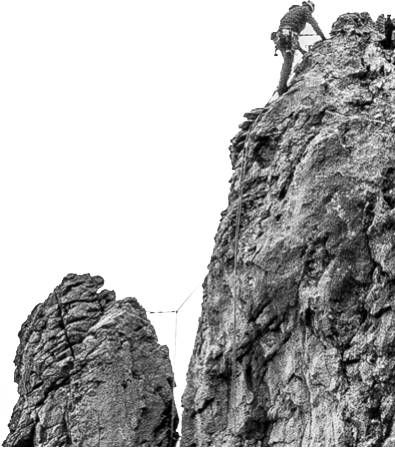Kazimierz Dabrowski’s theory of positive disintegration can be challenging to understand. It’s full of terms that only make sense after you’ve done the academic work needed to understand what Dabrowski meant by them—things like “multilevel disintegration,” “inner psychic milieu,” and “subject-object in oneself.”
A dedicated student can grasp the meaning of these terms after reading descriptive academic texts. To really see the power of these concepts, however, there’s nothing better than a story—show, don’t tell, as creative writing instructors say. And when it comes to positive disintegration, there may be no better example of this than the profiles written by Dr. Michael Piechowski, a psychologist and biologist who worked with Dabrowski. Piechowski’s profiles detail the processes of disintegration and growth toward secondary integration and inner peace in exemplars like like humanitarian leader Eleanor Roosevelt, activist Peace Pilgrim, writer and Holocaust victim Etty Hillesum, and UN Secretary General Dag Hammarskjold. In the stories of these remarkable individuals’ lives, we see the process of positive disintegration play out, bringing the language of the theory to life.
It’s therefore my pleasure to present to Third Factor’s readers my exchange with Dr. Piechowski, who kindly agreed to an e-mail conversation about his work. In this first of a two-part series, we talk about the value of studying those who seem to have gone through the process of positive disintegration and achieved the highest level defined by Dabrowski. In our next issue, we’ll look more at this path as compared to other developmental trajectories (including the one known in TPD as unilevel disintegration) and about what research into positive disintegration might look like in the future.
Jessie Mannisto: Why did you and Dr. Dabrowski study exemplars? Was it simply an effort to prove the theory?
Michael Piechowski: A theory with all its new terms is just a skeleton. When we can see those terms in how people live their lives the theory begins to gain some flesh on its bones. The people who exemplify a high level of development are fascinating and inspiring. Their lives stand out by their self-awareness, sense of responsibility, and being active and deliberate in their outward life or their inner life, or both.
JM: Is there a certain personality type who fits the general developmental track that progresses from level III to V? Or are they quite varied?
MP: Is there a general developmental track from III to V? The theory outlines such a track, but in real life, if you trace the development of the four people I studied—Eleanor Roosevelt, Etty Hillesum, Peace Pilgrim, and Bret Dofek—their paths have been very different. The first two had unhappy childhoods; the other two had happy ones. Three of them were very energetic but Etty was not.
JM: How did you choose your subjects? Did you know how to recognize good candidates when you saw them?
MP: The theory helps to find exemplars of advanced development. That’s one of its advantages. The theory provides criteria by which to recognize advanced level of development. I knew of Eleanor Roosevelt from reading Maslow who included her among self-actualizing people. Then a student of mine wanted to do a Master’s thesis to find out what made her a self-actualizing person.
JM: Eleanor Roosevelt is a wonderful example. I’d encourage Third Factor readers to track down the profile you did of her in Volume 2 of Advanced Development Journal (January 1990), from which I’ll share a teaser:
There were many transformations in Eleanor’s life. On her honeymoon in England, she was stumped by a question about the difference between state and federal courts in the United States. She felt ashamed of her ignorance and vowed to learn how government works. Although she grew up with prejudice against Negroes and Jews, Jews later were among her closest friends. She also had close friends among blacks and became an effective champion of their rights. […]
In the beginning of her career as a public speaker, she was awkward and unskilled. Her voice was high-pitched, and she often giggled nervously. But she became such an effective speaker that she could cast a spell over a whole political convention […].
Behind these remarkable changes lay a deeper, personal transformation. As a young woman Eleanor was shy, awkward, unsure of herself, socially inhibited, feeling highly self-conscious and homeless. In 1933, the first year in the White House, she was known as a woman of energy and ability, who impressed everyone by her serenity and poise, and also as one capable of turning up in the most unexpected places, such as coal mines and gunboats. From someone who earlier did not dare to voice her opinion, she became a person whose authority was widely respected. How did she bring about all these transformations and why did she do all the things that she did?
As a young woman Eleanor was shy, awkward, unsure of herself, socially inhibited. In 1933, she was known as a woman of energy and ability, who impressed everyone by her serenity and poise. How did she bring about all these transformations?
Michael Piechowski
I know I’ve just quoted quite a long passage (and merely the introduction at that), but I hope it will pique people’s interest! (The real heart of that article is an analysis of the intellectual and emotional components of Roosevelt’s development.)
And that leads me to my next question: in your view, why should people read the stories of these exemplars? Who in particular would benefit from reading them?
MP: Who should read them? Anyone who wants to understand the theory, anyone interested in the reality of people who are not self-serving but live their lives with a deep sense of what is right to do.
When I taught an undergraduate course in personality theory, I gave the students a description of the characteristics of self-actualizing people and asked them to find people who might fit the description. And they found them. And as you know, self-actualizing people fit the criteria for level IV in the theory. So, having found cases representing level V, it makes it easier to find them among us. And finding them lifts us from the gloom and depression about the state of the world.
JM: There was a passage I read in another piece you wrote for Advanced Development Journal, “The Roots of Dabrowski’s Theory,” that I would love to discuss more with you. It seems to speak to why someone might get something out of reading these profiles that you wrote. Here it is:
Because the process takes the person by surprise, he called it spontaneous, and because of the vertical tension, he called it multilevel, and because it shakes up the psyche, a disintegration. It is a process of inner transformation that may be very difficult. The suffering is no doubt greatest for those who find it hard to advance, and also when they are all alone without even a written word to guide them, a description that would fit their experience. The lives of Eleanor Roosevelt, Etty Hillesum, the mystics, and the cases Dabrowski collected, illustrate the process vividly (Mróz, 2009;Nixon, 1989, 1990, 1994, 2010; Piechowski, 1990, 1992, 2008). The theory is a powerful tool enabling one to assist gifted adolescents or adults according to the nature of their growth process.
MP: That passage says it better than what I just wrote. LOL! But I need to add that such lives are meaningful only to those who resonate with them. There were people who ridiculed and persistently criticized Eleanor Roosevelt; there are people among us who though devoted to Dabrowski’s theory nevertheless think that Peace Pilgrim was crazy. And that presents a paradox. Because if you understand the theory, including level V, then there could be no question that she represents a very advanced level V.
Such lives are meaningful only to those who resonate with them. There were people who ridiculed and persistently criticized Eleanor Roosevelt; there are people among us who though devoted to Dabrowski’s theory nevertheless think that Peace Pilgrim was crazy. And that presents a paradox.
Michael Piechowski
JM: You said in your Dabrowski Congress 2018 keynote that people at level V are much more common than TPD orthodoxy might have it—
MP: I didn’t say “much more common” but “not as rare” as we tend to think.
JM: Got it. That’s important, considering my next question: In addition to the examples you’ve studied and published on, is there anyone who appears to you to be an exemplar of level IV-V in contemporary culture? You mentioned Malala Yousufzai in an article, I think. Is she one? Are there others?
MP: Greta Thunberg comes to mind, but both she and Malala are still young. One would expect that they would follow the path of advanced development, but we are not there yet.
There are people among us who are working quietly for the benefit of others. They may be in leadership positions or not. There were several such subjects in a dissertation I know of, but no proper names. They may be outdoor educators working with the handicapped, those who work with the homeless, or those who work for peace.
JM: Is it truly the role of the level IV-V individual to “lift the level of society,” as I’ve heard people state?
MP: If you ask, is it their role, I begin to wonder who assigned the role. If people of advanced level of development are ignored, ridiculed, or burned at the stake we cannot speak of lifting the level of society. I think that people who resonate with those wonderful people are certainly uplifted, and some are likely to follow and do a lot of good for others.
I think that people who resonate with those wonderful people are certainly uplifted, and some are likely to follow and do a lot of good for others.
Michael Piechowski
JM: Are there any books or movies you recommend that showcase lives at level IV-V for non-experts in TPD?
MP: Eleanor Roosevelt’s You Learn by Living is down-to-earth and yet tough. For instance: “Self-knowledge develops slowly.… But if you keep trying honestly and courageously, even when the knowledge makes you wince, even when it shocks you and you rebel against it, it is apt to come in flashes of sudden insight.” It is remarkable that in her essay The Moral Basis of Democracy, she declares that democracy cannot be achieved unless everyone follows a high spiritual ideal and lives it.
Peace Pilgrim’s Her Life and Work in Her Own Words is also down-to-earth and tough. Both require strong will and determination. Then there are Etty Hillesum’s diaries, one of the most detailed accounts (I know of no other but they must exist) of multilevel growth and inner transformation.
As for movies, that’s a question for someone who knows movies. The one that comes to my mind is the documentary Won’t You be My Neighbor? and A Beautiful Day in the Neighborhood, which I have not seen, but suggest based on the article by Tom Junod, the man whom Fred Rogers befriended and won over his cynicism. Junod wrote that few people recognize the real depth of Fred Rogers. Peaceful Warrior, based on the life of Dan Millman [ed. note: an author and speaker on personal development], is another movie I’d recommend.




